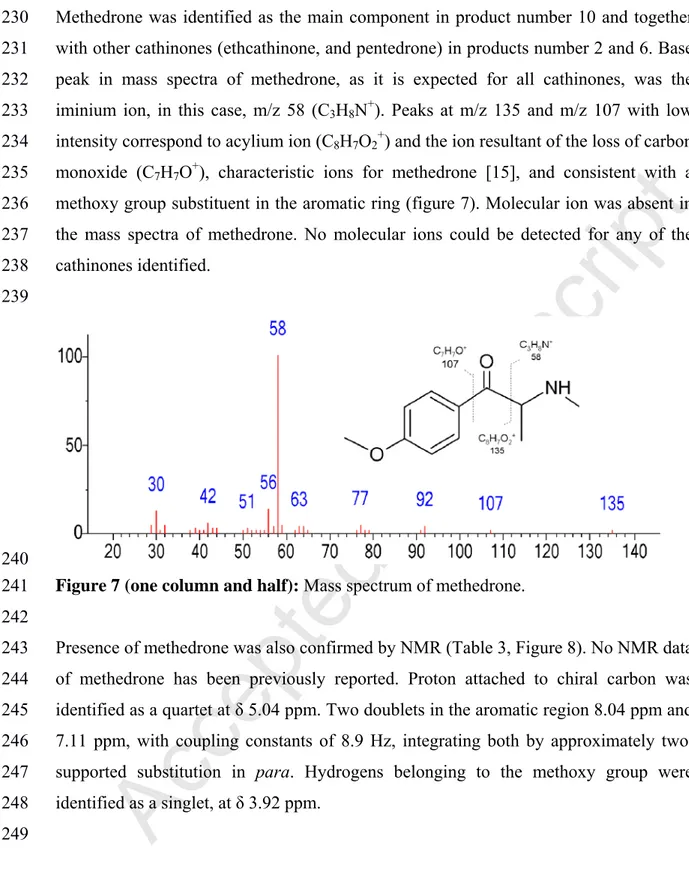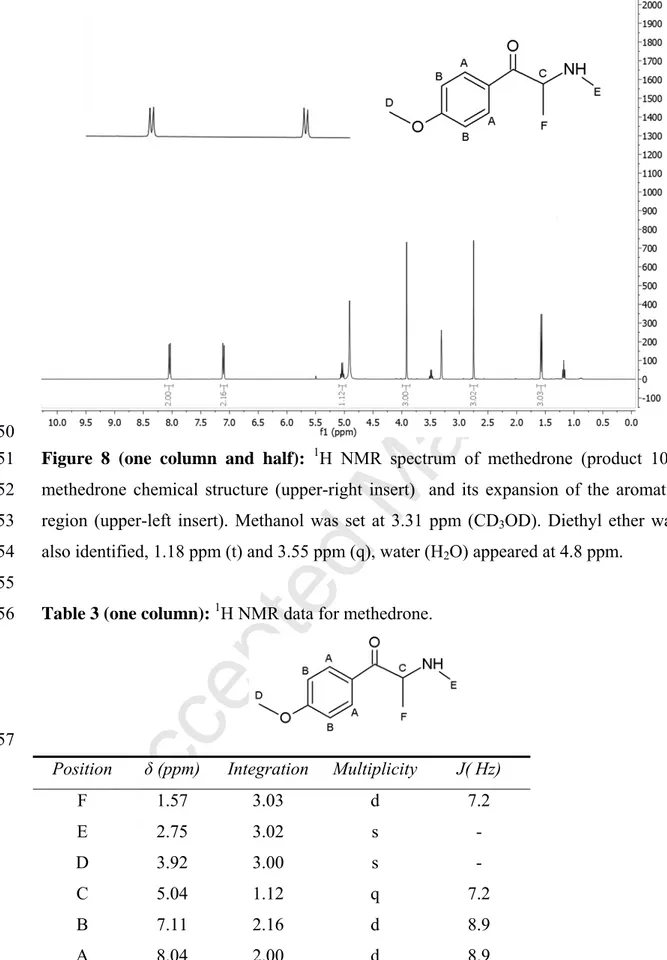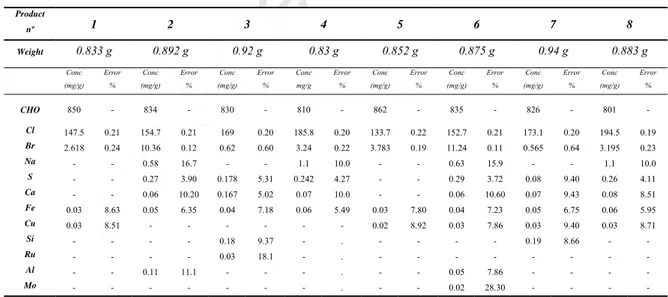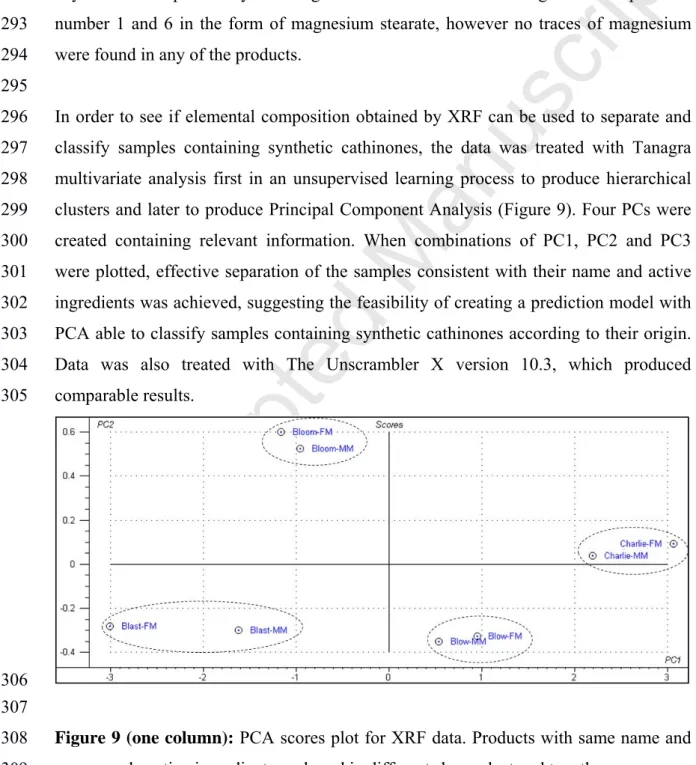Analytical profiles of "legal highs" containing cathinones available in the area of Lisbon, Portugal
Texto
(2) 38. Dimethylmethcathinone and 4-Methylethcathinone.. Analytical profiles of all the. 39. samples were obtained and compared.. 40. Elemental composition of the products was obtained by XRF analysis. The inorganic. 41. profiles obtained contain useful information and can be used to distinguish and classify. 42. samples according to their origin.. 43. rip. t. 44. Keywords: “Legal highs”; Cathinones; Methedrone; Elemental composition; X-Ray. 46. fluorescence.. us c. 45. Ac. ce. pt e. d. M. an. 47. 2 Page 2 of 30.
(3) 47 48 49. Acknowledgements. 50 The authors would like to thank the European Commission for funding of this project. 52. through the Erasmus Mundus Program, Rosário Bronze for performing GC-MS, Marta. 53. Carrasco for NMR spectroscopy and José Brito for obtaining the XRF data and for his. 54. time and support.. rip. t. 51. Ac. ce. pt e. d. M. an. us c. 55. 3 Page 3 of 30.
(4) 55. Introduction. 57. “Legal highs” have been banned in many countries during the last years. The. 58. government of Portugal announced the intention of banning these substances on. 59. November 2012, based on the Council Decision 2005/387/JHA on information. 60. exchange, risk-assessment and control of new psychoactive substances submitted by the. 61. European Commission with the support of EMCDDA, its Scientific Committee,. 62. Europol and Member States. Final version of the new law (Decreto-Lei nº54/2013. 63. Portaria 154/2013) was published on the April 17th 2013 in “Diário da República, 1.ª. 64. série - N.º 75 - 17 de abril de 2013” together with a list of 159 substances that became. 65. illegal to possess, sell or distribute. This list includes 34 cathinone derivatives [1].. 66. The new Portuguese legislation was based on the “precautionary principle” of risk. 67. assessment with a wide scope on new psychoactive substances (NPS) generally. 68. considered as “…substances not specifically framed and controlled under ongoing. 69. specific legislation that, in pure form or in a preparation, can pose a threat to public. 70. health comparable to the substances contained in that legislation, with danger to life or. 71. to health and physical integrity due to effects on the central nervous system and that. 72. may induce significant changes in motor function as well as mental functions, namely,. 73. critical judgment and reasoning behaviour, often with states of delirium, hallucinations. 74. or extreme euphoria and that can cause addiction and, in certain cases, produce lasting. 75. or even permanent damage on the health of consumers.”. 76. Consumption of these substances not only implies the risk due to their psychoactive and. 77. toxic properties, but the hazard of containing additional toxic compounds, such as. 78. leaching metals from the reaction vessels, residues of catalysts, dyes and contamination. 79. in adulterants or diluents. Manganese poisoning is a possibility in users if permanganate. 80. was used in their synthesis and they are not correctly purified [2] . Methoxylated. 81. derivatives present a special case of toxicity. Methedrone (4-Methoxymethcathinone). 82. has been given its name trivially, too similar to mephedrone which implies the risk of. 83. misidentification. 84. paramethoxymethamphetamine (PMMA) and it has been responsible for at least two. 85. fatalities [3], where it was found in concentration similar to concentration levels. 86. quantified in livings. Methedrone has shown to release norepinephrine and dopamine. Ac. ce. pt e. d. M. an. us c. rip. t. 56. by. consumers.. Methedrone. is. the. β-keto. analogue. of. 4 Page 4 of 30.
(5) similar to PMMA and paramethoxyamphetamine (PMA) [4]. These drugs have same. 88. effects as 3,4-methylenedioxy-N-methylamphetamine (MDMA), but with a lower onset,. 89. leading the users to consume more. The results are a quicker increase in body. 90. temperature and blood pressure as well as in blood concentration and more hazardous. 91. than MDMA. They have a particular high toxicity and narrow therapeutic window. 92. linked with the methoxy group. Accordingly, PMA and PMMA have been responsible. 93. of at least 6 fatalities [5]. Hence, it seems that methedrone recreational use entails. 94. higher risks than consumption of other related compounds.. 95. This study presents the results of a wide range of analysis on 13 “legal highs” products. 96. that were purchased in three different “smart shops” in the area of Lisbon. Synthetic. 97. cathinone derivatives were found in all the products (Figure 1).. 98. ce. pt e. d. M. an. us c. rip. t. 87. Figure 1 (one column and half): Chemical structures, molecular formula and molecular weight of cathinone derivatives identified in this study.. 101 102 103. Materials and methods. 104. purchased from Sigma-Aldrich (Germany) and were analytical grade.. 105 106 107. Gas Chromatography Mass Spectrometry. 108. A gas chromatograph mass detector GC-MS Shimadzu GC-2010 (Kyoto, Japan) with a. 109. column Varian Factor Four VF-5ms (30 m x 0.25 mm x 0.25 µm) was used. 2 µl of. Ac. 99 100. Methanol used as solvent for the GC-MS analysis and methanol-d4 used for NMR were. 5 Page 5 of 30.
(6) sample at a concentration of 0.5 mg/ml was injected in split mode 1:50. Helium was the. 111. carrier gas. The initial temperature was 80 ºC, held for 1 min, then increased till 150 ºC. 112. at 15 ºC/min, maintained for 5 min and finally increased to 295 ºC at 25 ºC/min, and. 113. held for 3 minutes more. The injector temperature was 250 ºC and the GC-MS interface. 114. transfer line temperature was 280 ºC. The mass spectrometer was operated in Electron. 115. Ionization mode (EI) with electron beam energy of 70 eV. The range 29-450 m/z was. 116. collected. Mass spectra were compared with NIST MS libraries for “legal highs” [6,7].. rip. t. 110. 117 Fourier Transform Infrared Spectroscopy. 120. Samples were screened by Attenuated Total Reflectance (ATR)-FTIR using a Perking. 121. Elmer Spectrometer 65 (Massachusetts, USA) equipped with the software “Perkin. 122. Elmer Spectra”. 20 mg of each product was placed directly in the instrument. The IR. 123. spectra were obtained in the range of 4000 to 600 cm-1, with 35 scans at 4 cm-1. 124. resolution. Spekwin32 software for optical spectroscopy, Version 1.71.6.1, was used for. 125. processing and visualizing the spectra. FTIR spectra of products number 1-8 were also. 126. obtained after being irradiated with XRF.. M. an. us c. 118 119. d. 127 X-Ray Fluorescence. 130. Products number 1-8 were analysed by WD-XRF. The whole remaining amount of each. 131. product, approximately 0.9 g, was placed in a Bruker plastic-film vial specific for XRF. 132. analysis. Products were analysed with a Bruker S4 Pioneer, in the range of 0-30 kV at. 133. an intensity of 134 mA and energy 4.02 kW in helium atmosphere. Software used for. 134. spectra analysis was “Spectra plus (Bruker)”.. 135 136 137. Ultraviolet-Visible Spectrometry. 138. A Perkin Elmer Lambda 25 UV/Vis Spectrometer was used to obtain the UV-visible. 139. spectra of the products to evaluate the unexpected change in colour occurred due to X-. 140. Rays irradiation. Products were analysed with a slit width of 1 nm at a scan speed of. 141. 480 nm/min. 5 mg of products number 1-8 were dissolved in 1 ml of distilled water and. 142. placed in a quartz micro cuvette.. Ac. ce. pt e. 128 129. 6 Page 6 of 30.
(7) 143 144 145. Proton Nuclear Magnetic Resonance. 146. 1. 147. 293 K. The measurements were performed on a Bruker ARX-400 (Bruker Bio Spin. 148. GmbH, Karlsruhe, Germany) operating at 400 MHz. 5 mg of each sample were. 149. dissolved in 500 µl of methanol d-4 (CD3OD), which was also used as a reference.. 150. Results and discussion. 151 152. Products evaluation. 153. All the products were presented as white powders in small plastic bags with striking. 154. designs and names labels. The information provided with the products was in general. 155. poor, written in English, Portuguese or both languages. Some of the products were. 156. labelled as “plant feeders” and “not for human consumption”. Modes of use were. 157. described per square meter or per plant, with a recommended dose of 0.2 grams.. 158. General information was inconsistent for products 1 and 6. Ingredients of these products. 159. were described per capsule, although they were presented in powder. Products labelled. 160. with the same name but with different lot number, advertised different ingredients, such. 161. as in the case of Blast (products nº 1, 5 and 9) and Bloom (nº 2 and 6). Previous studies. 162. has also found inconsistent information provided regarding the ingredients of “legal. 163. highs” [8]. According to the average price of the products. 164. compared with 8-10 euros per gram reported in 2010 [9]), it seems that “legal highs”. 165. containing cathinone derivatives increased their price in the last years or the price in. 166. Portugal was higher than the average in the European Union.. 167. Table 1 (one column): Number assigned to each product, and summary information. 168. including name, weight, price, origin and active ingredients identified.. (38 Euros per gram. Ac. ce. pt e. d. M. an. us c. rip. t. H NMR spectra of products number 1, 4, 10 and 13 were obtained at a temperature of. PRODUCT NUMBER. LEGAL HIGH NAME. SMART SHOP. WEIGHT ADVERTISED. PRICE. ACTIVE INGREDIENTS DETECTED. 1. Blast. Magic Mushroom Lisbon. 1g. 36 €. 4-Fluoromethcathinone Caffeine. 2. Bloom. Magic Mushroom Lisbon. 1g. 36 €. Ethcathinone Methedrone Pentedrone Caffeine. 7 Page 7 of 30.
(8) Blow. Magic Mushroom Lisbon. 1g. 38 €. 4-Methylethcathinone Caffeine. 4. Charlie. Magic Mushroom Lisbon. 1g. 37 €. Ethcathinone Buphedrone. 5. Blast. Free Mind Lisbon. 1g. 36 €. 4-Fluoromethcathinone Caffeine. 6. Bloom. Free Mind Lisbon. 1g. 36 €. Ethcathinone Methedrone Pentedrone Caffeine. 7. Blow. Free Mind Lisbon. 1g. 38 €. 4-Methylethcathinone Caffeine. 8. Charlie. Free Mind Lisbon. 1g. 37 €. 9. Blast. Magic Mushroom Almada. 0.5 g. 19.5 €. 10. Bliss. Magic Mushroom Almada. 0.5 g. 11. Blow. Magic Mushroom Almada. 0.5 g. 12. Charlie. Magic Mushroom Almada. 13. Invader Space Ship. Magic Mushroom Almada. rip Ethcathinone Buphedrone. us c. 4-Fluoromethcathinone Caffeine. Methedrone. 20.5 €. 4-Methylethcathinone Caffeine. an. 16.5 €. 0.5 g. 20 €. Ethcathinone Buphedrone. 0.250 g. 10.5 €. 3,4-DMMC. M. 169 170. t. 3. Chemical analysis. 172. Active ingredients were found in all thirteen “legal highs” products purchased for this. 173. study. 174. Fluoromethcathinone. 175. pentedrone, 3,4-Dimethylmethcathinone (3,4-DMMC) and 4-Methylethcathinone (4-. 176. MEC).. 177. ATR-FTIR spectra of products were consistent with the molecular structure of synthetic. 178. cathinones (figures 2-5). All spectra presented a very intense peak at 1680-1690 cm-1. 179. (stretch C=O), another intense peak at 1600 cm-1 (stretch C=C) due to the presence of. 180. an aromatic ring and bands with relative low intensity at frequencies near to 3200 cm-1. 181. and 2450-2490 cm-1 corresponding to an amine. Noticeable differences were found in. 182. the fingerprint region between 600 cm-1 and 1200 cm-1 for each product that helped to. 183. identify the synthetic cathinone present in the sample for products containing only one. 184. cathinone derivative as main component (products 1, 3, 5, 7, 9, 10, 11 and 13). This. 185. suggests relatively pure samples.. 186. undistinguishable IR spectra. IR spectra of 4-FMC, 4-MEC, methedrone and 3,4-. pt e. 1).. The. following. (4-FMC),. synthetic. ethcathinone. cathinones (EC),. were. buphedrone,. identified. 4-. methedrone,. Ac. ce. (Table. d. 171. Products labelled with the same name showed. 8 Page 8 of 30.
(9) DMMC have been previously published [10–13].. 188 189. Figure 2 (one column and half): FTIR spectra of product Blast (4-FMC).. 190 191. Figure 3 (one column and half): FTIR spectra of product Blow (4-MEC).. 192 193. Figure 4 (one column and half): FTIR spectra of product Bliss (methedrone).. Ac. ce. pt e. d. M. an. us c. rip. t. 187. 9 Page 9 of 30.
(10) t rip Figure 5 (one column and half): FTIR spectra of product Invader Space Ship (3,4-. 196. DMMC).. us c. 194 195 197. It was confirmed by GC-MS analysis that products nº 1, 5 and 9 (labelled as “Blast”). 199. contain 4-FMC as a major ingredient. 1H NMR data supported the previous findings of. 200. MS and confirmed the presence of 4-FMC. See Table 2. Chemical characterization of 4-. 201. FMC is available in the literature[10].. 202. d. Table 2 (one column): 1H NMR data for 4-FMC.. 204. δ (ppm). Ac. Position. ce. pt e. 203. M. an. 198. Integration. Multiplicity. J( Hz). E. 1.58. 3.06. d. 7.2. D. 2.77. 3.04. s. -. C. 5.10. 1.06. m. 7.2. A. 7.35. 2.00. t. 8.7. B. 8.15. 2.03. m. -. 205 206. 4-MEC was identified as main ingredient of products 7 and 11 (“Blow”). Analytical. 207. data of 4-MEC has been published [11]. EC was found in products number 2 and 6 and 10 Page 10 of 30.
(11) together with buphedrone in products 4, 8 and 12. Retention times of cathinone. 209. derivatives under GC conditions have been reported [14] and helped to confirm the. 210. identity of chemicals present in the samples. Fragmentation patterns of cathinones have. 211. been previously proposed and observed under EI conditions [15,16]. Fragmentation. 212. patterns observed on the mass spectra of products containing buphedrone and. 213. ethcathinone were very similar; both compounds produced the same characteristic ions.. 214. The 1H NMR spectrum confirmed the presence of the both compounds together in a. 215. sample (figure 6). Both compounds showed the signal corresponding to the protons. 216. from chiral carbon atoms of buphedrone and ethcathinone overlapped, and appeared as. 217. a multiplet. However, the number of remaining signals, corresponding to the alkyl. 218. substituent chain was the twice that it would be expected in the presence of only one. 219. compound. The intensity of the signals was approximately half of the expected value. 220. compared with the intensity of signals assigned to aromatic protons, indicating the. 221. presence of both, buphedrone and EC in similar amounts. Methanol (CD3OD), used as. 222. solvent, was set at 3.31 ppm on the NMR spectra. Water also appeared in all the spectra. 223. at 4.8 ppm, presumably due to the hygroscopic character of methanol.. M. an. us c. rip. t. 208. Ac. ce. pt e. d. 224. 225 226. Figure 6 (one column and half):. 227. ethcathinone and buphedrone). Methanol was set at 3.31 ppm (CD3OD). Diethyl ether. 228. was also identified, 1.18 ppm (t) and 3.55 ppm (q), water (H2O) appeared at 4.8 ppm.. 1. H NMR spectra of product 4 (containing. 229 11 Page 11 of 30.
(12) Methedrone was identified as the main component in product number 10 and together. 231. with other cathinones (ethcathinone, and pentedrone) in products number 2 and 6. Base. 232. peak in mass spectra of methedrone, as it is expected for all cathinones, was the. 233. iminium ion, in this case, m/z 58 (C3H8N+). Peaks at m/z 135 and m/z 107 with low. 234. intensity correspond to acylium ion (C8H7O2+) and the ion resultant of the loss of carbon. 235. monoxide (C7H7O+), characteristic ions for methedrone [15], and consistent with a. 236. methoxy group substituent in the aromatic ring (figure 7). Molecular ion was absent in. 237. the mass spectra of methedrone. No molecular ions could be detected for any of the. 238. cathinones identified.. rip. t. 230. Figure 7 (one column and half): Mass spectrum of methedrone.. pt e. 240 241. d. M. an. us c. 239. 242. Presence of methedrone was also confirmed by NMR (Table 3, Figure 8). No NMR data. 244. of methedrone has been previously reported. Proton attached to chiral carbon was. 245. identified as a quartet at δ 5.04 ppm. Two doublets in the aromatic region 8.04 ppm and. 246. 7.11 ppm, with coupling constants of 8.9 Hz, integrating both by approximately two,. 247. supported substitution in para. Hydrogens belonging to the methoxy group were. 248. identified as a singlet, at δ 3.92 ppm.. Ac. 249. ce. 243. 12 Page 12 of 30.
(13) t rip us c an. Figure 8 (one column and half): 1H NMR spectrum of methedrone (product 10),. 252. methedrone chemical structure (upper-right insert) and its expansion of the aromatic. 253. region (upper-left insert). Methanol was set at 3.31 ppm (CD3OD). Diethyl ether was. 254. also identified, 1.18 ppm (t) and 3.55 ppm (q), water (H2O) appeared at 4.8 ppm.. d. M. 250 251. Table 3 (one column): 1H NMR data for methedrone.. ce. 256. pt e. 255. Ac. 257 Position. δ (ppm). Integration. Multiplicity. J( Hz). F. 1.57. 3.03. d. 7.2. E. 2.75. 3.02. s. -. D. 3.92. 3.00. s. -. C. 5.04. 1.12. q. 7.2. B. 7.11. 2.16. d. 8.9. A. 8.04. 2.00. d. 8.9. 258 259 13 Page 13 of 30.
(14) 260 NMR revealed the presence of diethyl ether in all the samples analysed, δ 1.18 ppm (t). 262. and δ 3.55 ppm (q). Diethyl ether is used as a solvent for the base compounds in a final. 263. step of the most syntheses proposed for cathinones, and to obtain the hydrochloric or. 264. hydrobromic salts of cathinones and amphetamines by dissolving or bubbling HCl gas. 265. on the diethyl ether [17–19], which are the most probable sources of diethyl ether. 266. contamination found in the products.. rip. t. 261. 267 268. X-Ray Fluorescence. us c. 269. Wavelength dispersive X-Ray Fluorescence (WD-XRF) was used to obtain an inorganic. 271. chemical profile of products 1-8. Concentrations of light elements (C, H, O and N) are. 272. expressed as approximations referred to concentration of cellulose for universal. 273. calibration. Chlorine, bromine, sodium, sulphur, calcium, iron, copper, silicon,. 274. aluminium, ruthenium and molybdenum were identified in different quantities on the. 275. products.. M. an. 270. 276. d. Table 4 (two columns): Elemental composition of products 1-8, concentration is expressed in mg of element by grams of sample and error in %. Product. pt e. 277 278 279. nº. 1. 2. 3. 4. 5. 6. 7. 8. Weight. 0.833 g. 0.892 g. 0.92 g. 0.83 g. 0.852 g. 0.875 g. 0.94 g. 0.883 g. Error. Conc. %. (mg/g). CHO. 850. -. 834. -. Cl. 147.5. 0.21. 154.7. Br. 2.618. 0.24. 10.36. Na. -. -. 0.58. Ac. S. Error. Conc. Error. Conc. Error. Conc. Error. Conc. Error. Conc. Error. Conc. Error. %. (mg/g). %. mg/g. %. (mg/g). %. (mg/g). %. (mg/g). %. (mg/g). %. 830. -. 810. -. 862. -. 835. -. 826. -. 801. -. 0.21. 169. 0.20. 185.8. 0.20. 133.7. 0.22. 152.7. 0.21. 173.1. 0.20. 194.5. 0.19. 0.12. 0.62. 0.60. 3.24. 0.22. 3.783. 0.19. 11.24. 0.11. 0.565. 0.64. 3.195. 0.23. 16.7. -. -. 1.1. 10.0. -. -. 0.63. 15.9. -. -. 1.1. 10.0. ce. Conc (mg/g). -. -. 0.27. 3.90. 0.178. 5.31. 0.242. 4.27. -. -. 0.29. 3.72. 0.08. 9.40. 0.26. 4.11. -. -. 0.06. 10.20. 0.167. 5.02. 0.07. 10.0. -. -. 0.06. 10.60. 0.07. 9.43. 0.08. 8.51. 0.03. 8.63. 0.05. 6.35. 0.04. 7.18. 0.06. 5.49. 0.03. 7.80. 0.04. 7.23. 0.05. 6.75. 0.06. 5.95. 0.03. 8.51. -. -. -. -. -. -. 0.02. 8.92. 0.03. 7.86. 0.03. 9.40. 0.03. 8.71. -. -. -. -. 0.18. 9.37. -. .. -. -. -. -. 0.19. 8.66. -. -. -. -. -. -. 0.03. 18.1. -. .. -. -. -. -. -. -. -. -. Al. -. -. 0.11. 11.1. -. -. -. .. -. -. 0.05. 7.86. -. -. -. -. Mo. -. -. -. -. -. -. -. .. -. -. 0.02. 28.30. -. -. -. -. Ca Fe Cu Si Ru. 280 281 282 283 284. The high amounts of chlorine detected in the samples (13.4 % to 19.4 %) together with 14 Page 14 of 30.
(15) the absence of any sing of covalent chlorine in the GC-MS and H1 NMR analysis. 286. indicated that cathinones were in hydrochloric salt form. This chlorine was. 287. stoichiometrically in agreement with the quantity of cathinones estimated by the amount. 288. of carbon, hydrogen and oxygen detected, confirming high purity of cathinones present. 289. on the samples. Bromine was the second more abundant element detected in all the. 290. samples, but in a much lower level than chlorine, discarding the possibility of synthetic. 291. cathinones presented as hydrobromic salt. No manganese or chromium was detected in. 292. any of the samples analysed. Magnesium was advertised as ingredient in products. 293. number 1 and 6 in the form of magnesium stearate, however no traces of magnesium. 294. were found in any of the products.. us c. rip. t. 285. 295. In order to see if elemental composition obtained by XRF can be used to separate and. 297. classify samples containing synthetic cathinones, the data was treated with Tanagra. 298. multivariate analysis first in an unsupervised learning process to produce hierarchical. 299. clusters and later to produce Principal Component Analysis (Figure 9). Four PCs were. 300. created containing relevant information. When combinations of PC1, PC2 and PC3. 301. were plotted, effective separation of the samples consistent with their name and active. 302. ingredients was achieved, suggesting the feasibility of creating a prediction model with. 303. PCA able to classify samples containing synthetic cathinones according to their origin.. 304. Data was also treated with The Unscrambler X version 10.3, which produced. 305. comparable results.. Ac. ce. pt e. d. M. an. 296. 306 307 308. Figure 9 (one column): PCA scores plot for XRF data. Products with same name and. 309. same psychoactive ingredient purchased in different shops clustered together.. 310 15 Page 15 of 30.
(16) Unexpected change in colour was observed in different extent on the products after X-. 313. Ray irradiation. Products number 1 and 5 turned pink, whilst products 4 and 8 turned. 314. orangeish. The rest of the products lost their pure white colour. UV-Vis spectra of. 315. products 1-8 after X-Ray irradiation were compared with UV-Vis spectra from the. 316. original products, however no differences were found in the spectra taken before and. 317. after X-ray irradiation. No absorption bands were found in the visible region for. 318. products that change colour. This suggested a reversion in the colour when diluting the. 319. salt in distilled water.. 320. FTIR and NMR did not reveal any additional information; the spectra were identical to. 321. the ones obtained for all the products in their previous states independently of their. 322. acquired colours, supporting the absence of chemical changes in products predicted by. 323. the non-destructive character of XRF as analytical technique. The change in colour. 324. observed remitted gradually in one week, until being just barely appreciable. However,. 325. the difference in colour between irradiated and non-irradiated products could still be. 326. noticed several weeks after exposure.. M. an. us c. rip. t. 311 312. 327. Conclusions. 330. The products studied in this project contained active ingredients either as single. 331. component or in mixtures. All cathinones derivatives identified (4-FMC, EC,. 332. buphedrone, methedrone, pentedrone, 3,4-DMMC, 4-MEC) belong to the “classic. 333. cathinones group”, analogues of amphetamines, being considered as the first generation. 334. of “legal highs” [20].. 335. IR spectrometry can be used to identify the cathinone derivative present in “legal highs”. 336. samples which are highly pure and only contain one cathinone derivative.. 337. As a result of the change in legislation it was not possible to purchase more products. 338. and evaluate their consistency on time. Although the changes on Portuguese legislation. 339. seem far from being able to solve the problem that “legal highs” represent to society.. 340. The list of banned substances by Portuguese law comprises 159 substances, however, as. 341. the EMCDDA has reported 199 new substances classified as “legal highs” a minimum. 342. of 40 substances remain yet in a “legal void”, actually only few of the possible. 343. cathinone derivatives or isomers are listed, and new substances are continually. 344. appearing. Hence, new modifications in the Portuguese legislation will need to be taken. Ac. ce. pt e. d. 328 329. 16 Page 16 of 30.
(17) in future. Still a completed list of cathinone derivatives that can be synthetized seems. 346. unrealistic. Instead, more generic controls (whole family of cathinones) seem better. 347. approach.. 348. The available data from New Zealand, United Kingdom (UK) or Germany shows that. 349. by banning these substances a decrease in their availability is reached, however, these. 350. actions have not been able to make them disappear, and although banned, they are often. 351. seized and appear to be summed up to the current illegal market of drugs [21,22]. On. 352. the basis of what has happened in other countries these products may remain in the. 353. Portuguese market even after being forbidden.. 354. Identification of novel psychoactive substances is an arduous task for forensic. 355. laboratories due to the great number of substances present in the market in last years,. 356. very high prices or absence of standards, and subtle differences among these substances.. 357. None or few studies have been published evaluating human toxicity, potential for. 358. addiction, acute overdose or long-term effects. Thus, toxicological evaluation needs to. 359. be performed in order to elucidate relative potency among different derivatives, possible. 360. interactions with other drugs as well as neurotoxicity and behaviour toxicity of synthetic. 361. cathinones. In order to guarantee public health, these products should be monitored. 362. regularly, the new substances identified and the knowledge of the scientific community. 363. increased by producing reliable analytical data of these compounds.. 364. Trace metals found in the products might be present in raw materials, reagents or. 365. solvents used, or they can be contamination from the equipment used during the. 366. synthesis, instead of being intendedly introduced. These trace metals can function as. 367. important chemical markers and may serve to distinguish between samples [23]. To the. 368. best of author knowledge this is the first time than inorganic profiles of samples. 369. containing synthetic cathinones are presented. Products showed different elemental. 370. compositions between them, but very similar for the products labelled with the same. 371. name (Table 3). Products nº 1 and 5 (Blast) and nº 2 and 6 (Bloom) purchased in. 372. different smart shops and also with different ingredients advertised clustered together. 373. suggesting a common origin. These chemicals are most probably synthetized in. 374. “underground” laboratories, following simple and inexpensive synthetic routes using. 375. easily obtainable starting materials, the chemicals synthetized will depend on the. 376. demand as well as the availability of precursor materials. Several synthetic pathways. 377. have been proposed for substituted cathinones [22–24], with the use of the. 378. corresponding propiophenone and bromine being the easiest and most probable. The. Ac. ce. pt e. d. M. an. us c. rip. t. 345. 17 Page 17 of 30.
(18) inorganic composition may provide information about synthetic pathways. It is difficult. 380. to know if bromide present comes from a synthesis using reactives containing bromo or. 381. from any other source of contamination. But chemicals obtained by different synthetic. 382. routes will show different inorganic profiles. If forensic laboratories have a large. 383. enough number of seize samples, the inorganic composition could help to link several. 384. seizures to the same producer and to classify seized samples.. 385 386. References. 387 388. [1]. Decreto-Lei no54/2013 Portaria 154/2013, 2254 3 -, https://dre.pt/pdf1sdip/2013/04/07500/0225402257.pdf. (2013) 2254–2257.. 389 390. [2]. EMCDDA, Synthetic cathinones, www.emcdda.europa.eu/publications/drugprofiles/synthetic-cathinones, (2012).. 391 392 393. [3]. M. Wikström, G. Thelander, I. Nyström, R. Kronstrand, Two Fatal Intoxications with the New Designer Drug Methedrone ( 4-Methoxymethcathinone ) Autopsy cases, J. Anal. Toxicol. 34 (2010) 594–598.. 394 395 396 397. [4]. L.D. Simmler, a Rickli, M.C. Hoener, M.E. Liechti, Monoamine transporter and receptor interaction profiles of a new series of designer cathinones., Neuropharmacology. 79C (2013) 152–160. doi:10.1016/j.neuropharm.2013.11.008.. 398 399 400. [5]. S.S. Johansen, a C. Hansen, I.B. Müller, J.B. Lundemose, M.-B. Franzmann, Three fatal cases of PMA and PMMA poisoning in Denmark., J. Anal. Toxicol. 27 (2003) 253–256. doi:NO_DOI.. 401 402 403. [6]. SWGDRUG. Scientific Working Group for the Analysis of Seized Drugs (SWGDRUG) SWGDRUG MS Library Version 1.8 (Visited 09.04. 2013). Available at: http://www.swgdrug.org/ms.htm, (n.d.).. 404 405. [7]. Cayman Chemical. Cayman Spectral Library V 05162013. (Visited 16.05.2013) at https://www.caymanchem.com/app/template/SpectralLibrary.vm, (2013).. 406 407. [8]. 408 409. [9]. J. Hillebrand, D. Olszewski, R. Sedefov, Legal highs on the Internet., Subst. Use Misuse. 45 (2010) 330–40. doi:10.3109/10826080903443628.. 410 411. [10]. R.P. Archer, Fluoromethcathinone, a new substance of abuse., Forensic Sci. Int. 185 (2009) 10–20. doi:10.1016/j.forsciint.2008.11.013.. 412 413. [11]. P. Jankovics, A. Váradi, L. Tölgyesi, S. Lohner, J. Németh-Palotás, H. KoszegiSzalai, Identification and characterization of the new designer drug 4’-. Ac. ce. pt e. d. M. an. us c. rip. t. 379. M. Baron, M. Elie, L. Elie, An analysis of legal highs: do they contain what it says on the tin?, Drug Test. Anal. 3 (2011) 576–81. doi:10.1002/dta.274.. 18 Page 18 of 30.
(19) 414 415 416 417. methylethcathinone (4-MEC) and elaboration of a novel liquid chromatographytandem mass spectrometry (LC-MS/MS) screening method for seven different methcathinone analogs., Forensic Sci. Int. 210 (2011) 213–20. doi:10.1016/j.forsciint.2011.03.019. [12]. Scientific Working Group for the Analysis of Seized Drugs (SWGDRUG) Monographs., Http://www.swgdrug.org/monographs.htm. (n.d.).. 420 421 422. [13]. J.F. Casale, P.A. Hays, Differentiation of 3,4-Dimethylmethcathinone (3,4DMMC) from its Dimethyl Aryl-Positional Isomers, Microgram J. 9 (n.d.) 75– 83.. 423 424 425. [14]. W.G. and R.U. Viorica Lopez-Avila*, A. Technologies, S. Clara, Mass spectral fragmentation of cathinones by high-resolution TOFMS using a soft ionization source, J. Pharm. Sci. Innov. Re Search Artic. 1 (2012) 44–53.. 426 427 428. [15]. D. Zuba, Identification of cathinones and other active components of “legal highs” by mass spectrometric methods, TrAC Trends Anal. Chem. 32 (2012) 15– 30. doi:10.1016/j.trac.2011.09.009.. 429 430 431. [16]. C.R. Maheux, C.R. Copeland, Chemical analysis of two new designer drugs: buphedrone and pentedrone., Drug Test. Anal. 4 (2012) 17–23. doi:10.1002/dta.385.. 432 433 434 435. [17]. L. Aalberg, K. Andersson, C. Bertler, M.D. Cole, Y. Finnon, H. Huizer, et al., Development of a harmonized method for the profiling of amphetamines. II. Stability of impurities in organic solvents., Forensic Sci. Int. 149 (2005) 231– 241. doi:10.1016/j.forsciint.2004.06.019.. 436 437 438 439 440. [18]. O.I.G. Khreit, M.H. Grant, T. Zhang, C. Henderson, D.G. Watson, O.B. Sutcliffe, Elucidation of the Phase I and Phase II metabolic pathways of (±)-4’methylmethcathinone (4-MMC) and (±)-4'-(trifluoromethyl)methcathinone (4TFMMC) in rat liver hepatocytes using LC-MS and LC-MS2., J. Pharm. Biomed. Anal. 72 (2013) 177–85. doi:10.1016/j.jpba.2012.08.015.. 441 442 443 444. [19]. J.D. Power, P. McGlynn, K. Clarke, S.D. McDermott, P. Kavanagh, J. O’Brien, The analysis of substituted cathinones. Part 1: chemical analysis of 2-, 3- and 4methylmethcathinone., Forensic Sci. Int. 212 (2011) 6–12. doi:10.1016/j.forsciint.2011.04.020.. 445 446 447. [20]. 448 449 450. [21]. Ac. ce. pt e. d. M. an. us c. rip. t. 418 419. D. Zuba, B. Byrska, Prevalence and co-existence of active components of “legal highs,” Drug Test. Anal. DOI 10.1002/dta.1365. (2012) available online at: wileyonlinelibrary.com/journa. doi:10.1002/dta.1365. S.D. Brandt, H.R. Sumnall, F. Measham, J. Cole, Analyses of second-generation “legal highs” in the UK: initial findings., Drug Test. Anal. 2 (2010) 377–382. doi:10.1002/dta.155.. 19 Page 19 of 30.
(20) [22]. G.S. Winder, N. Stern, A. Hosanagar, Are “Bath Salts” the next generation of stimulant abuse?, J. Subst. Abuse Treat. (2012) doi:10.1016/j.jsat.2012.02.003. doi:10.1016/j.jsat.2012.02.003.. 454 455 456 457. [23]. R.S. Ortiz, K.C. Mariotti, N. V Schwab, G.P. Sabin, W.F.C. Rocha, E.V.R. de Castro, et al., Fingerprinting of sildenafil citrate and tadalafil tablets in pharmaceutical formulations via X-ray fluorescence (XRF) spectrometry., J. Pharm. Biomed. Anal. 58 (2012) 7–11. doi:10.1016/j.jpba.2011.09.005.. 458 459 460. [24]. M. Osorio-olivares, C. Rezende, S. Sepu, B.K. Cassels, R.F. Baggio, J.C. Mun, A two-step method for the preparation of homochiral cathinones, 14 (2003) 1473– 1477.. 461 462. [25]. H. Belhadj-Tahar, N. Sadeg, Methcathinone: a new postindustrial drug., Forensic Sci. Int. 153 (2005) 99–101. doi:10.1016/j.forsciint.2005.04.023.. 463 464. [26]. R.P. Archer, K. Williams, J. Wiley, Reference materials for new psychoactive substances, (2011) 505–514. doi:10.1002/dta.317.. us c. rip. t. 451 452 453. an. 465. Ac. ce. pt e. d. M. 466. 20 Page 20 of 30.
(21) • • • • •. We produced a snapshot of the availability of “legal highs” in Portugal. Analytical data of the novel psychoactive substances identified are presented. Methedrone, a special case of toxicity of cathinones, was found in three samples. Elemental composition of samples was obtained by XRF. Inorganic profiles can be used to identify common origin of samples.. t. 470 471 472 473 474. Highlights:. rip. 466 467 468 469. us c. 475 476. Ac. ce. pt e. d. M. an. 477. 21 Page 21 of 30.
(22) Ac. ce. pt. ed. M. an. us. cr. i. Figure 1. Page 22 of 30.
(23) Ac. ce. pt. ed. M. an. us. cr. i. Figure 2. Page 23 of 30.
(24) Ac. ce. pt. ed. M. an. us. cr. i. Figure 3. Page 24 of 30.
(25) Ac. ce. pt. ed. M. an. us. cr. i. Figure 4. Page 25 of 30.
(26) Ac. ce. pt. ed. M. an. us. cr. i. Figure 5. Page 26 of 30.
(27) Ac. ce. pt. ed. M. an. us. cr. i. Figure 6. Page 27 of 30.
(28) Ac. ce. pt. ed. M. an. us. cr. i. Figure 7. Page 28 of 30.
(29) Ac. ce. pt. ed. M. an. us. cr. i. Figure 8. Page 29 of 30.
(30) Ac. ce. pt. ed. M. an. us. cr. i. Figure 9. Page 30 of 30.
(31)
Imagem
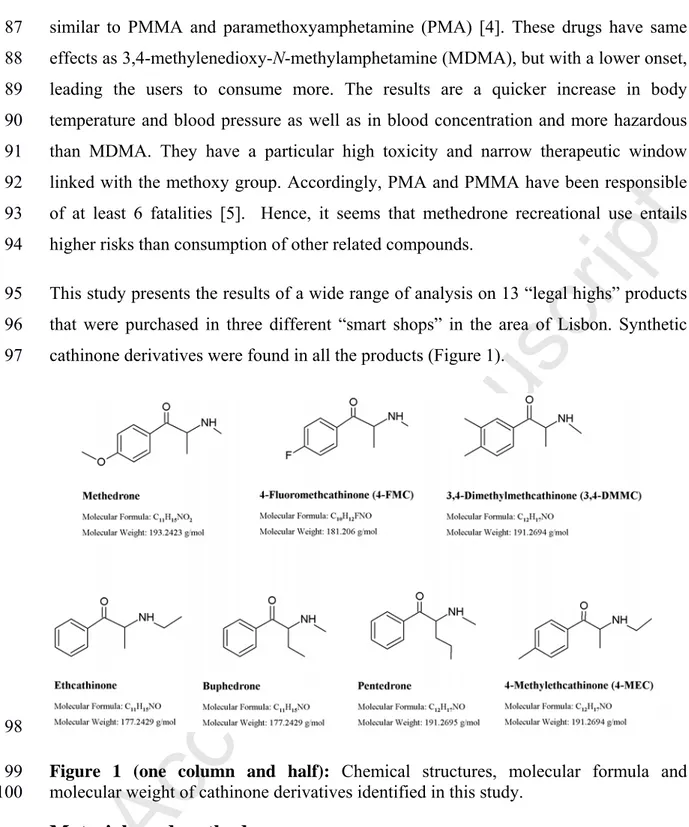

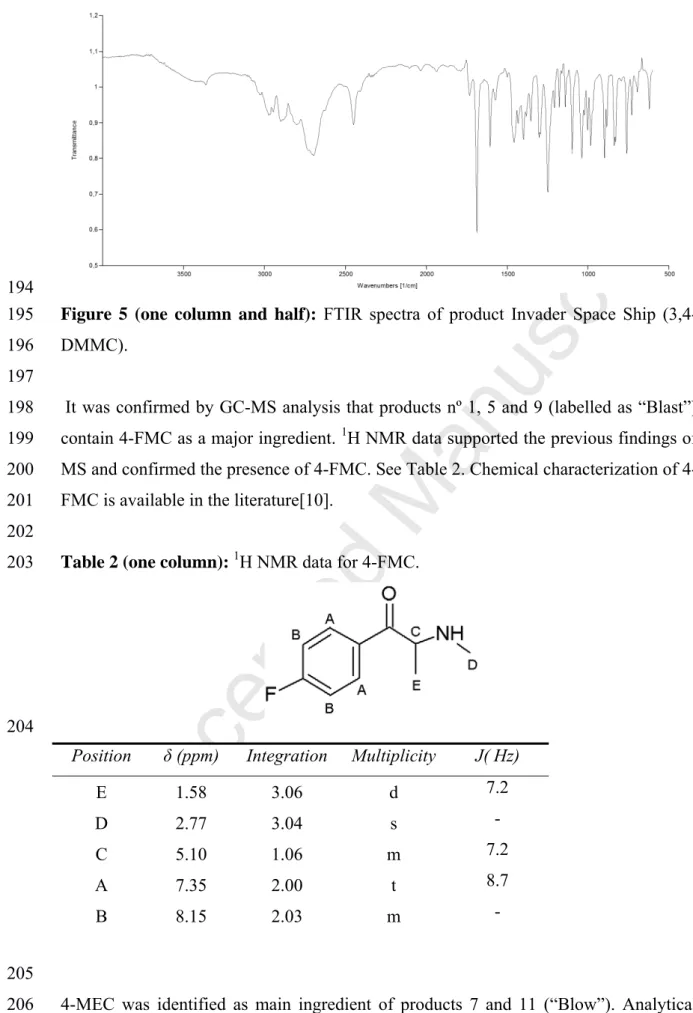
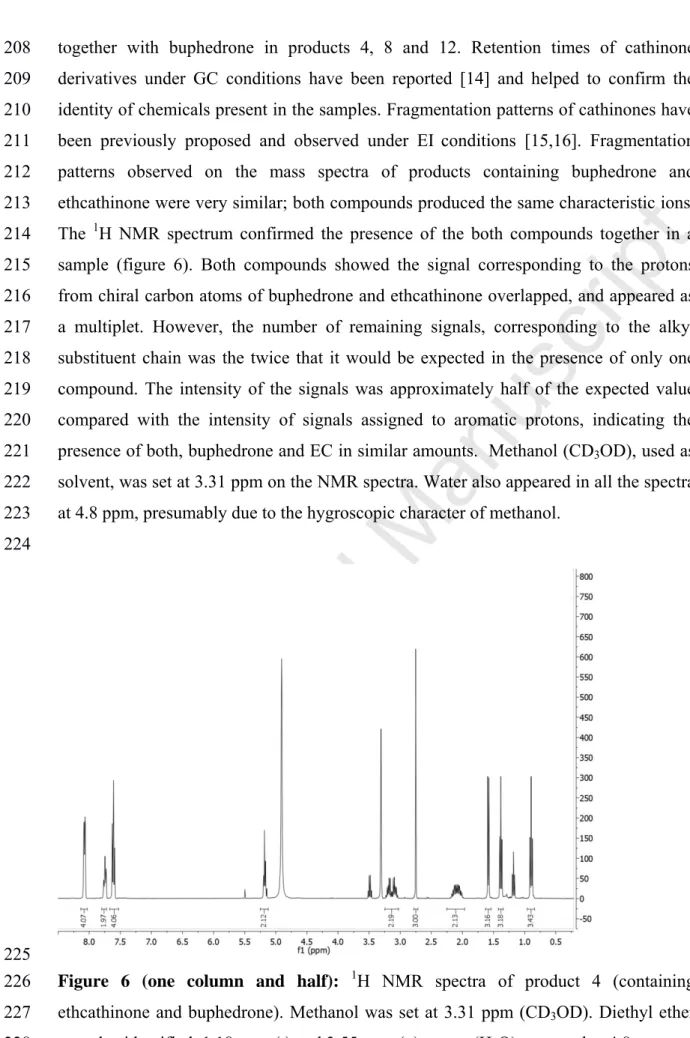
Documentos relacionados
Figure 3 represents the FTIR spectra of synthetic aluminosilicate and natural aluminosilicate (metakaolin), while Figure 4 shows the spectra of synthetic aluminosilicate
Professores e estudantes de História serão compelidos a realizar cada um dos micro-objectivos fixados pelo MEC a cada 17 minutos (= 112,5 minutos de aulas semanais
Neste artigo temos como objetivo geral discutir a importância de atividades lúdicas no desenvolvimento da Educação Matemática, e como objetivos específicos:
Tal como foi referido anteriormente, este estudo tinha como objectivo avaliar a relação entre as competências psicológicas, o traço de ansiedade e o rendimento
O papel da endarteriectomia como tratamento de primeira linha na prevenção de acidentes isquémicos cerebrais em doentes com estenose carotídea permaneceu assim por definir
FTIR spectra of cyclodextrins and of the corresponding gold nanoparticles, hydrodynamic size distribution and absorbance spectra of the nanoparticles synthesized by direct heating
It follows that the column space of A and the nullspace of A t are orthogonal complements of each other under the euclidean inner product in R m..
As shown in the table 2 there are 27 core indicators of sustainable tourism that are divided into four sections, such as destination management core indicators, economic
